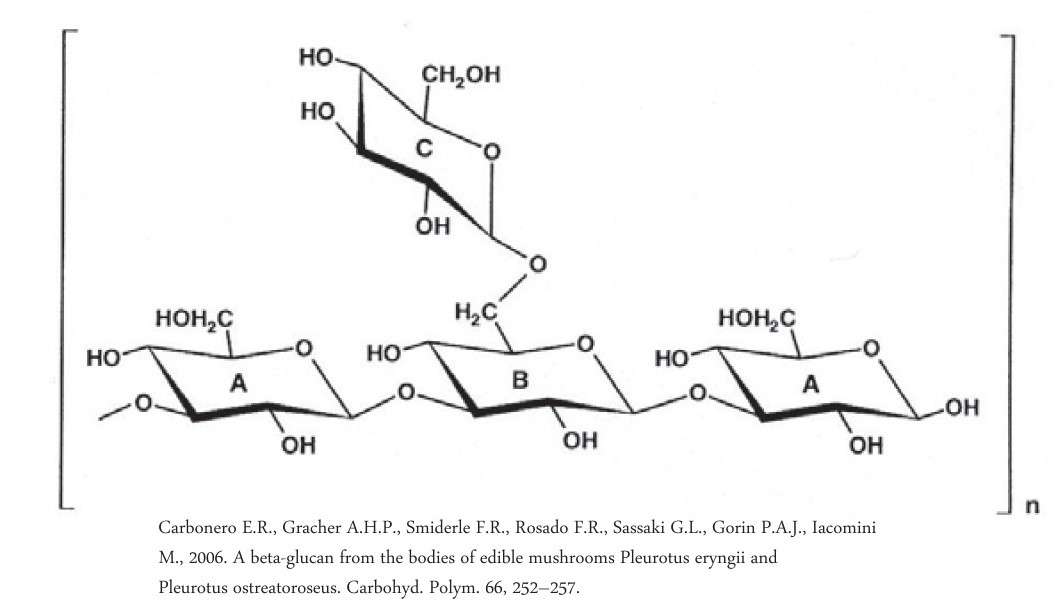
Hlíva ústřičná (Pleurotus ostreatus, anglicky ‒ oyster mushroom, japonsky ‒ hiratake) je celosvětově velmi dobře známá houba, která je dostupná snad v každém obchodě i čerstvé.
Názvy houby vycházejí z tvaru její plodnice. Latinsky je pleurotus rostoucí bokem/boční, takto je umístěna nožka ke klobouku houby. Ostreatus pak poukazuje na tvar houby, která připomíná ústřici. I názvy v dalších jazycích vychází právě z této podobnosti. Uvádí se, že i chuťově je hlíva blízká ústřici.
Hlíva je dřevokazná houba, která preferuje chladnější zeměpisná pásma. Roste v trsech na poškozených a mrtvých listnatých stromech, kdy rozkladem dřeva získává živiny. Co je však málo známé, houby z rodu Pleurotus jsou také „masožravé“. Jejich podhoubí umí zabít a strávit nematodu (hlístice). Díky tomu, že hlíva není pro stromy parazit, ale saprofyt, napomáhá vrátit živiny do půdy při rozkladu mrtvého či poškozeného dřeva, tím je dodá i dalším rostlinám.
Hlíva ústřičná je po tisíciletí součástí tradiční čínské medicíny. První písemné zmínky o hlívě se nacházejí v Shennong Bencao Jing materii medice. Hlíva byla již v dávné historii natolik žádaná, že byla i kultivována a cíleně pěstována. Tento fakt byl popsán v roce 199 našeho letopočtu. Zařazení hlívy do vědeckých textů proběhlo v roce 1775, kdy ji popsal dánský přírodovědec N. J. Freiherr. V té době ji ovšem zařadil do rodu nečárkovitých, až později byla hlíva přeražena do rodu Pleurotus německým mykologem P. Kummerem.

Krom tradičních medicín je houba využívána také v kuchyni, a to hlavně asijské. Je nedílnou součástí japonské, korejské a čínské kuchyně. Může být podávána samotná, ale také v polévkách, omáčkách, zeleninových a masových směsích. Houba je chuťově nejlepší, pokud je sbírána mladá, se stárnutím je tužší a i vůně se mění na značně nepříjemnou. Pro některé lidi může být hůře stravitelná a způsobovat jim trávicí obtíže, to je dáno přítomností arabitolu, cukerného alkoholu.
Vzhledem k tomu, že je hlíva hodně poptávána, je komerčně pěstována, kultivována.
Může růst na volných prostranstvích, na speciálně sestavených substrátech nebo také na substrátech v polyetylenových pytlích.
Substráty jsou vytvořeny tak, aby zajistily houbě co nejlepší růst a dostatek živin. Nejčastěji obsahuje piliny, škrob, obiloviny, dřeň z kávových zrn, kakao, ořechové a kokosové slupky, semena bavlníku, banány, stébla trav a kukuřice, jetel, rýže a mnoho dalšího. Substrát se musí pasterizovat či jinak zajistit, aby neobsahoval bakterie, plísně a další možné kontaminanty. Připravený substrát se inokuluje připravenými houbovými mycelii, které jej kolonizují, a pak vytvoří plodnice. Při tomto procesu je nutné udržet správnou teplotu, vlhkost a koncentrace kysličníku uhličitého.
Samozřejmě se také pěstována na stromech, tedy hlavně polenech a existují i způsoby pěstování na slámě.
Hlíva ústřičná je velmi bohatá na bioaktivní sloučeniny, které se mohou zapojit do ději probíhajících v organismu a upravit je.
Jako jiné houby je i hlíva velmi bohatá na cukerné složky. Nejvíce jsou zastoupeny polysacharidy, složené cukry. Mezi polysacharidy patří sloučeniny, které nejsou rozpustné ve vodě a jsou tzv. hrubou vlákninou (celulóza, chitin), ale důležitější jsou ve vodě rozpustné polysacharidy, tj. glukany.
Jedná se o hlavně o beta glukany, které jsou větvené v pozicích (1→3), (1→6). Pro hlívu je typický polysacharid, který byl nazván pleuran. V tomto polysacharidu jsou mezi molekulami glukózy (1→3) beta vazby, postranní řetězce jsou tvořeny glukopyranózovými molekulami. Glukózové molekuly v postranních řetězcích jsou k hlavnímu řetězci vázány přes (1→4) nebo (1→6) vazbu. Molekulární hmotnost je 600‒700 kDa. Přikládáme část molekuly pleuranu:

Dalšími sloučeninami obsahujícími cukry jsou mannany, galaktiny a xylany.
Z hlívy je možné získat krom polysacharidů také jednotlivé cukerné molekuly, tj. monosacharidy. Jedná se o glukózu a galaktózu.
Polysacharidy, byť jsou majoritní, nejsou jedinou součástí hub. Hlíva je také bohatá na aminokyseliny a bílkoviny. Aminokyseliny jsou stavební prvky bílkovin a z mnohých je možné v době nedostatku živin vytvořit také hlavní energetickou sloučeninu pro fungování mozku a svalů, tj. glukózu.
Hlíva obsahuje aminokyseliny jak neesenciální, které si dovede tělo samo vytvořit, tak esenciální, které je nutné do těla dodávat. V hlívě je v největší míře zastoupena kyselina glutamová, aspartová, je zde také tyrosin, alanin, histidin, glycin, arginin, serin, tryptofan, leucin, izoleucin, treonin, metionin atd.
Mezi důležité bílkoviny v hlívě patří enzymy. Hlíva je schopná rozkládat dřevní hmotu, obsahuje tedy celulázy, hemicelulázy, laktázy, amylázy atd. Obsahuje také enzymy, které redukují oxidační stres, interagují s volnými radikály a neutralizují je, jedná se např. o superoxiddismutázu, peroxidázy a katalázy.
Hlívu je také možné využít k rozkládání některých toxických látek, které se hromadí v přírodě a jsou neodbouratelné. Jedná se např. o některé herbicidy, pesticidy, antibiotika atd. Enzymy z hlívy je mohou rozložit na neaktivní a neškodné látky.
Hlíva také uvolňuje malé sekreční bílkoviny (small secreted proteins), tyto jsou tvořeny z aminokyselin, kterých je méně než 300. Hrají důležitou roli např. při infekci, která postihuje houbu, a modulují její obrannou reakci, jsou také důležité pro symbiotický život a degradaci mnohých látek, včetně dřeva a látek toxických.
Důležitou složkou hlívy je také kyselina gama aminomáselná, kterou známe hlavně pod zkratkou GABA, která je také neurotransmiterem. Dále je přítomen také ornitin, který je prekurzorem syntézy argininu (prekurzor je látka, ze které se „vyrobí“ konečný produkt).
Hlíva také obsahuje dvě bílkoviny, které nejsou v žádné jiné houbě. Jsou to osteolysin a pleurotolysin. Bílkoviny mají cytolytický účinek, tj. narušují buněčné membrány, což vede k poškození buňky a její smrti. Ale aby se tyto účinky projevily při pojídání hlívy, museli bychom zkonzumovat doslova desítky kilogramů. V pokusech se ukázalo, že pro hlodavce je nebezpečná dávka 1170 mikrogramů na kilogram živé váhy myši, pokud je podán v čisté podobě do žíly. Intoxikace osteolysinem a pleurotolysinem se projeví jako zpomalení srdeční činnosti, snížením krevního tlaku, srdeční ischemií. Dochází k poškození erytrocytů, uvolnění hemoglobinu a draslíku do krevního oběhu. Objevuje se také narušení plicních funkcí, což ale úzce souvisí s poškozením srdečně-cévního systému.
Houby jsou jedny z mála neživočišných zástupců, kteří obsahují tuky nejen v semenech. Hlíva je nositelkou jak nasycených mastných kyselin, tak těch nenasycených. Mezi nenasycené mastné kyseliny, které jsou v hlívě, patří kyselina olejová, linolová a arachidonová. Z nasycených můžeme zmínit stearovou či palmitovou.
Vitální houby, a tedy i hlíva jsou bohaté na fenoly, terpeny a další sloučeniny od nich odvozené. Tyto látky mají výrazný antioxidační účinky, jsou testovány v pokusech na rakovinných buňkách a s patogeny. Výsledky vychází pozitivně.
Do skupiny těchto látek (mezi steroly a steroidy) patří i vitamín D2, ergosterol, dále pak cerevisterol.
Mezi terpeny, které dodávají hlívě mírně nahořklou chuť, patří např. ergosta-5,7,22-trien-3-ol, ergosta-5,7,9(11),22-tetraen-3, ergost-5,8(14)-dien-3-ol, D-xenialaktol.
Dále jsou v hlívě fenylové a fenolové sloučeniny: kumariny, např. 3-(2-indolyl)isokumarin, 2,4-bis(1,1-dimethyl ethyl či 2,5-di-tertbutylphenol, 2,5-dihydroxybenzoová kyselina, kyselina ferulová, kyselina skořicová, vanilová, naringenin atd.
Z hlívy je také možné extrahovat flavonové sloučeiny morin, quercetin a resveratrol.
V nedávné studii (2018) autoři také popsali 5 nafto-gama-pyronů, 2 skupiny izomerů: fonsecinon B, asperpyron F; asperpyron C, fonsecinon A a aurasperon A. tyto látky byly testovány pro jejich protibakteriální účinky, a to i na multirezistentním stafylokokovi či E. coli.
Hlíva též obsahuje mnohé minerální látky, které získává ze svého životního prostředí. Jde hlavně o draslík, vápník, sodík, hořčík, zinek, selen, železo, mangan atd.
Pro názornost přikládáme přehled fytosloučenin hlívy. Ukazuje, jak komplexní hlíva je. Nejsou tam samozřejmě polysacharidy a bílkoviny
Důležitou a jedinečnou součástí hlívy je také lovastatin, jedná se o sekundární metabolit, který se zapojuje do metabolismu cholesterolu. Jak již jeho název napovídá, jedná se o statin, které jsou běžně využívány také k léčbě vysokého cholesterolu u lidí. Statiny totiž blokují HMG-CoA reduktázy, enzym zapojený do syntézy cholesterolu.
Pro názornost přikládáme přehled fytosloučenin hlívy. Ukazuje, jak komplexní hlíva je. Nejsou tam samozřejmě polysacharidy a bílkoviny

Deepalakshmi, Krishnamoorthy & Mirunalini, Sankaran. (2016). Antiproliferative and apoptotic effect of Pleurotus ostreatus on human mammary carcinoma cell line (michigan cancer foundation-7). Cancer Translational Medicine. 2. 95. 10.4103/2395-3977.189303.

Traditional and time-tested tincture formulas

Skin care cosmetics
for natural beauty
